Apr
2025
The best stocks and shares Junior ISA providers
DIY Investor
6 April 2025
We run the rule over the best Junior ISA providers in the UK…by Jo Groves
Choosing the right Junior Individual Savings Account (JISA) provider can make a big difference to building a nest egg for your child’s future. Whether you’re saving towards their first car, university education or a deposit on their first home, a Junior ISA offers a tax-efficient way to help your child’s portfolio grow over time.
For example, if you contributed the maximum annual allowance (currently £9,000) each year from birth and the portfolio grew at an average annual rate of 9.6% (the average growth rate for a bond and equity ISA over the past decade), their Junior ISA could be worth over £430,000 by their 18th birthday.
To help you navigate through the multitude of options on offer, we’ve reviewed and selected the best Junior ISA providers in the UK, based on key criteria such as fees, customer service and the range of investments.
In our FAQs, we explain exactly how Junior ISAs work, including how to open an account, contribution limits, investment choices and associated fees.
Fees can make a serious dent in your Junior ISA
While a few percentage points of difference in fees may seem insignificant, they can add up to thousands of pounds over time. The chart below sets out the potential impact of these fees based on the actual platform fees charged by the providers in our selected group:
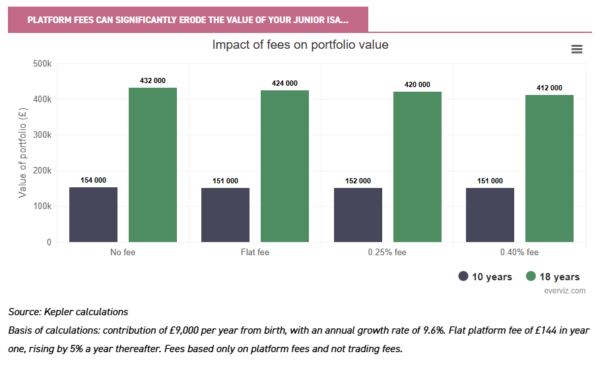
Assuming you contribute £9,000 per year and the portfolio grows by 9.6% a year, this would be the value of your child’s Junior ISA on their 18th birthday:
- No platform fees: the portfolio would be worth £432,000 if you picked one of the providers that doesn’t charge platform fees.
- Flat platform fee: based on a flat platform fee of £144 (and assuming a 5% increase each year), your Junior ISA would be worth £424,000, meaning that your fees would have totted up to £8,000.
- Percentage-based platform fee: the portfolio would be worth £420,000 and £412,000 for a 0.25% and 0.40% platform fee, meaning that you’ve paid £12,000 and £20,000 in fees.
And if you achieve a higher annual return on your investments, this gap could widen further…
Fees are set out in detail below but the following table summarises our indicative fee calculation by provider, with green being the cheapest for each portfolio value and red the most expensive.
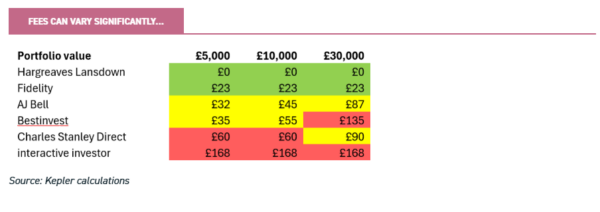
Should you open a cash or stocks & shares Junior ISA?
A stocks & shares JISA gives you the potential for higher returns than cash ISAs by investing in a wide range of assets such as shares, bonds and funds.
According to research by Moneyfarm, the average bond and equity ISA has returned 9.6% per annum, or 12.5% for a global equity portfolio, compared to just 1.2% for a cash ISA (based on the 10-year period to November 2024).
That said, it will depend on your appetite for risk as investments can go down (as well as up) in value. While stocks & shares JISAs have the potential to outperform cash JISAs, the value of investments can fall as well as rise and past performance is not a guarantee of future performance.
You should also factor in the length of time until your child reaches 18 (or when they would look to withdraw it from their adult ISA). It is generally not recommended to invest in the stock market if you might need to withdraw the money within a five-year time frame due to the peaks and troughs of the stock market.
The best Junior ISA providers
The following table sets out our pick of the best Junior ISA providers, with the methodology behind our rankings set out below (including the basis of our fee calculations).

Why we picked it
HL is one of the largest DIY investment platforms in the UK with over 1.9 million clients. It accepted an offer from a consortium of private equity firms last year and is expected to leave the London Stock Exchange in early 2024. HL offers a full suite of products, including a fund and share account, SIPP, Adult ISA and Lifetime ISA.
Clients have a wide range of more than 14,000 investment options, including UK and international shares and over 4,000 funds, 1,900 ETFs and 300 investment trusts. It also offers managed funds and multi-asset funds.
HL is a low-cost option for Junior ISAs having scrapped both trading and platform fees in 2023. However, it’s a more expensive option for adult ISAs so it might be worth revisiting providers when your child turns 18.
In terms of extras, HL pays interest on uninvested cash and provides customer support by phone and online messaging. It also provides extensive research on its website, including podcasts and webinars. It has one of the lower ratings of 4.2 on Trustpilot but scores highly for customer service amongst the personal experiences of the KTI team.
Overall, HL takes the top honours for our best Junior ISA provider, thanks to the combination of a premium service with no trading or platform fees.
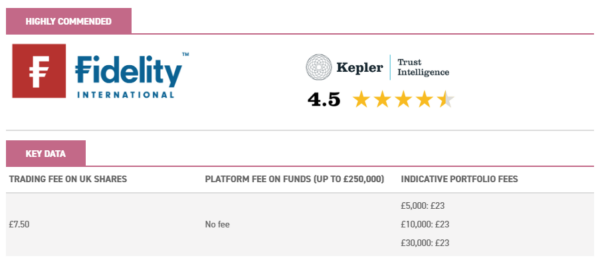
Why we picked it
Fidelity has over 1.6 million customers in the UK but, unlike some of its fund management peers, offers a wide range of third-party funds in addition to Fidelity funds. It also offers an investment account, SIPP and Adult ISA but no Lifetime ISA.
Clients can choose from over 2,400 UK and international shares, 2,900 funds, 400 ETFs and 170 investment trusts, although this is at the smaller end amongst our group. Fidelity has a range of ready-made and managed portfolios, as well as offering personalised finance advice.
Fidelity charges no platform fees on Junior ISAs but one of the higher trading fees of £7.50 although there is no trading fee for funds.
In terms of extras, Fidelity pays interest on uninvested cash held in an ISA and provides customer support by phone and online messaging. It also provides a good level of research on its website, including podcasts, but has one of the lower ratings of 4.4 on Trustpilot.
Overall, Fidelity is a good all-rounder, with no platform fees on Junior ISAs and a decent range of investments but the share trading fee could mount up for more frequent traders.

Why we picked it
AJ Bell is a FTSE 250 company with over 540,000 clients and offers a dealing account, SIPP, Adult ISA and Lifetime ISA.
Clients have a wide range of investment options, with over 15,000 UK and international shares, 3,000 ETFs, 4,000 funds and 380 investment trusts. It also offers a range of ready-made managed and non-managed portfolios.
In terms of fees, AJ Bell has one of the lowest platform fees amongst the mainstream providers, with a platform fee of 0.25%, capped at a maximum of £2.50 a month for share-based investments. Moving onto trading fees, it charges one of the lower fees of £5 for UK and international shares but charges £1.50 for trading in funds.
In terms of extras, AJ Bell pays interest on uninvested cash held in a Junior ISA, has an easy-to-use app and provides customer support by phone and live chat. It also provides a good level of educational information and holds regular webinars. It has a rating of 4.8 on Trustpilot, the highest among our selected group.
Overall, AJ Bell is an excellent all-rounder, offering competitive fees, the second-highest range of investment options and good customer service.
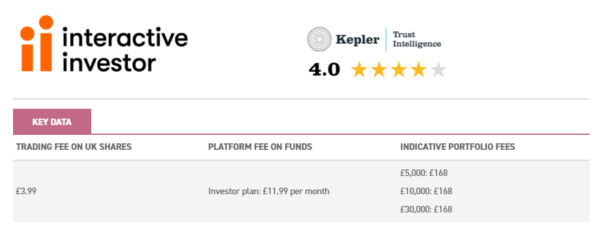
Why we picked it
interactive investor (ii) has over 430,000 clients and is owned by fund manager aberdeen but still offers third party funds. It also offers a trading account, SIPP and Adult ISA but does not offer a Lifetime ISA.
Clients have a wide range of investment options, with more than 40,000 investment options, including over 3,000 funds, 1,000 ETFs and a selection of investment trusts. It also offers managed funds and ‘quick-start’ multi-asset funds.
ii is one of the few platforms with a flat (rather than percentage-based) platform fee. The Junior ISA is included within the Investor plan which costs £11.99 per month and includes a trading account and Adult ISA. The Junior ISA is not included in the lower-cost Investor Essentials plan.
Moving onto trading fees, ii charges £3.99 for funds and UK and US shares, rising to £9.99 for other international shares, with the Investor plan including a free monthly trade.
In terms of extras, ii pays interest on uninvested cash held in an ISA and provides customer support by phone and live chat. It also provides extensive research on its website and has a rating of 4.7 on Trustpilot.
Overall, interactive investor may appeal to investors who already hold an adult account as there is no additional platform fee for a Junior ISA but is an expensive option if this isn’t the case.
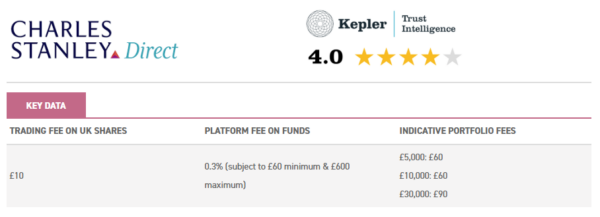
Why we picked it
Charles Stanley is a privately-owned company, having been bought by US investment firm Raymond James in 2022. It offers wealth management services in addition to DIY investing via Charles Stanley Direct. Clients have the choice of an investment account, ISA, Adult ISA and SIPP but no Lifetime ISA.
It offers a decent range of 12,500 investments, including shares, funds, ETFs and investment trusts, in addition to a selection of managed portfolios.
Charles Stanley Direct charges a platform fee of 0.30% on the value of investments held across all accounts, subject to an annual minimum fee of £60 and maximum fee of £600. There is no platform fee on the managed portfolios.
It charges one of the higher trading fees of £10 on shares and £4 on funds, however customers receive £50 worth of trading credits every six months.
Charles Stanley Direct provides a comprehensive level of research, including market commentary and webinars but has the lowest Trustpilot ratings of our selected providers at 4.0.
Overall, Charles Stanley Direct may appeal to parents wishing to change investments regularly due to the trading fee credits.
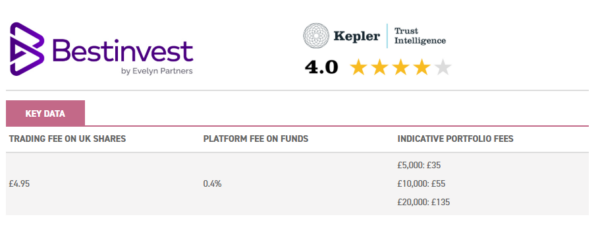
Why we picked it
Bestinvest is owned by wealth manager Evelyn Partners and has over 50,000 clients. It also offers an investment account, SIPP and Adult ISA but not a Lifetime ISA.
Clients can choose from over 1,100 shares, 1,600 funds, 330 ETFs and 280 investment trusts. It offers one of the widest ranges of ready-made portfolios, categorised by expert (maximising return), smart (low-cost, passive funds), direct (shares and bonds) and sustainable (ESG).
For funds and UK shares, the platform fee is 0.4% (up to £250,000) or 0.2% for US shares and ready-made portfolios. It charges a mid-range trading fee of £4.95 on UK shares and no fee on funds and US shares.
Bestinvest provides a telephone and live facility, as well as free one-on-one coaching. It provides a good level of research, including the annual ‘Spot The Dog’ review of underperforming funds but has one of the lower Trustpilot ratings amongst our selected providers at 4.4.
Overall, Bestinvest is a decent option but offers a more limited range of investments and the platform fee becomes expensive on higher-value portfolios.
Methodology
To come up with our list of best stocks & shares Junior ISA providers, we applied three main criteria. Our focus was on whether providers:
- charged competitive trading and platform fees
- offered customers a wide range of third-party investments
- had a good rating on consumer review site Trustpilot
We also considered other features such as our personal experience of the providers, whether ready-made portfolios were available and the option to hold other accounts such as Self-Invested Personal Pensions (SIPPs) and adult ISAs.
We calculated indicative fees on the following basis:
- Platform fees: for flat platform fees, we picked the cheapest option for a Junior ISA.
- Trading fees: six trades per year, split equally between funds and UK shares. For Charles Stanley Direct, we offset trading fees against the £100 of annual trading credits.
- Portfolio values: £5,000, £10,000 and £30,000.
- Split of portfolio: 50% UK shares/ETFs and 50% funds.
Frequently asked questions (FAQs)
What is a Junior ISA?
A Junior ISA (JISA) is a tax-efficient way of saving for a child up to the age of 18. You have the option to invest up to £9,000 per year (in the current 2025/26 tax year) in either a cash or stocks & shares JISA, or a combination of both.
The real appeal of a JISA lies in its tax advantages: any capital gains, dividends or interest earned within the JISA are free from income tax and capital gains tax. It is worth noting that money saved in a JISA can’t be accessed until the child turns 18, at which point it can be converted into an Adult ISA or withdrawn.
Who can open a Junior ISA?
To open a Junior ISA, the child must be under 18 and living in the UK. Children aged 16 and 17 can open their own JISA but if they are under 16, the account must be opened by a parent or guardian with parental responsibility. Once the JISA is opened, anyone (such as grandparents or family members) can pay money in.
The parent (or legal guardian) will manage the account until at least the child’s 16th birthday, although some providers don’t allow children under 18 to manage their own accounts. The money will belong to your child but they can’t withdraw it until they turn 18.
You can open most JISAs online in 10-15 minutes. You’ll have to provide your National Insurance number (as well as your child’s if they have one) and either invest a minimum lump sum or provide your bank details.
Your child can only hold one stocks & shares JISA and one cash JISA at any one time, though you can transfer a JISA (in full) to a new provider. If your child was born between 2002 and 2011, they may have a Child Trust Fund (CTF) which must be transferred if you wish to open a JISA instead.
Can the annual Junior ISA allowance be carried forward?
No, the £9,000 annual limit is on a ‘use it or lose it’ basis.
What can you invest in?
A stock & shares JISA offers a wide range of investment options to suit different goals and risk appetites. You can invest in individual company shares or opt for funds which pool your money with other investors to invest in a portfolio of assets. The range of investments will be determined by your ISA provider, with some offering thousands of different investment options.
There are two main types of funds to invest in:
- Actively-managed funds: these are professionally managed by fund managers who pick a basket of investments and typically charge an annual management fee of 0.5% to 1.0%.
- Passively-managed funds: also known as index, tracker or exchange-traded funds (ETFs), these track an index such as the FTSE 100 or S&P 500 and typically charge a lower annual management fee of 0.1% to 0.5%.
Alternatively, less-experienced investors may wish to consider the following managed options:
- Ready-made portfolios: these are offered by most of the mainstream platforms and provide a diversified portfolio of funds, usually categorised by risk appetite.
- Robo-advisers: these aim to provide a halfway house between personalised financial advice and DIY investing. Investors complete a questionnaire to determine their goals and appetite for risk which is used to build an automated portfolio.
- Financial advisers: these provide individual, tailored advice on portfolio construction and, as a result, are likely to be the most expensive option.
What fees will you pay?
It’s important to understand the fees involved as these can significantly impact your returns over time, as mentioned earlier. There are three main types of fees:
- Platform fee: this is a fee for holding investments on the provider’s platform and is usually calculated as a percentage of your total portfolio value (typically 0.25%-0.45% per year) but may be capped at a maximum amount per year. Alternatively, a small number of providers offer a flat fee or waive platform fees altogether on JISAs.
- Trading fee: you’ll typically pay a trading fee of £4 to £12 for buying shares (including ETFs and investment trusts) although some platforms offer commission-free trading. Trading fees for funds are generally lower or often zero.
- Fund management fees: as mentioned above, you’ll pay an annual management fee for investing in funds, which is typically between 0.1% and 1%.
In addition, if you trade non-UK shares, you will typically pay a foreign exchange fee of 0.5% to 1.0% and you may be charged a higher trading fee for these shares. You will also be charged Stamp Duty Reserve Tax (SDRT) of 0.5% on trades in individual UK company shares.
Can my child have more than one Junior ISA?
A child can only hold one of each type of Junior ISA at any time, being one cash JISA and one stocks & shares JISA. If you want to switch to a new provider, you’ll need to transfer the funds (in full) from the previous provider.
Can I open a Junior ISA for my grandchild?
Not unless you have legal parental responsibility for your grandchild. However, once the Junior ISA has been opened, anyone can pay money into it.
What happens to the Junior ISA when my child turns 18?
When a child turns 18, their Junior ISA will automatically convert into an Adult ISA of the same type. For example, a stocks & shares JISA will turn into a stocks and shares ISA. At this point, your child has full control and access to the funds, including withdrawing the money.
Most providers will write to you in advance of your child’s 18th birthday to explain the process, which typically includes your child registering for online access to manage the account.
With this in mind, it’s worth discussing how the money will be used before the child turns 18, such as paying for university fees, driving lessons or a house deposit.
Can I close a Junior ISA?
It is not possible to withdraw money or close a Junior ISA before the child turns 18 unless the child is diagnosed with a terminal illness or dies.
Can I move a Child Trust Fund into a Junior ISA?
Yes, a Child Trust Fund (CTF) can be transferred to a Junior ISA provided that you transfer the full amount. This will preserve the tax-free status of the account but it’s not possible to switch the money back to a CTF once moved.
How do I transfer my Junior ISA to a new provider?
The first step is to check that the new provider accepts Junior ISA transfers. In many cases, the underlying investments can be transferred without needing to sell and re-purchase them, but this depends on whether the new provider also offers these investments.
Partial transfers are not allowed as you are only allowed to hold one Junior ISA of each type (being cash and stocks & shares).
What about the fees on adult ISAs and SIPPs?
We’ve also produced guides to the best adult ISA providers and best SIPP providers for parents looking to hold all of their accounts with one provider.
Please note that tax treatment depends on your individual circumstances and rules may change.

Disclaimer
This is not substantive investment research or a research recommendation, as it does not constitute substantive research or analysis. This material should be considered as general market commentary.
Leave a Reply
You must be logged in to post a comment.